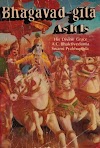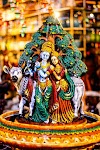BHAGAVAD GITA IN BRIEF
The Bhagavad Gita is divided into 3 parts
1. Chapter 1 to 6 (Karma Yoga)
2. Chapter 7 to 12 (Bhakti yoga)
3. Chapter 13 to 18 (Jnana yoga)
Part I: KARMA YOGA (CHAPTER 1-6)
Chapter 1: The Yoga of Arjuna’s Dejection
(arjuna-viṣāda-yoga)
Arjun is sitting on his
Chariot which was being driven by Lord Sri Krishna himself and becomes overwhelmed by compassion for his
cousins, elders and teacher present in the battlefield, against whom he was going
to fight. He could forsee no enjoyment in the victory and was very fearful of
the sinful reactions which may occur and was concerned about the the resultant
effects of destruction families at end of war so therefore Arjun decides not to
fight even if it meant giving up his Dharma to fight for righteousness of being
Kshatriya and letting the villains Kauravas rule prevail and continuation of
their atrocities on common man.
After hearing this disheartening
conversation on battlefield from Sanjay, Dhritrashtra- father of Kauravas became
hopeful of not losing the kingdom but Lord Sri Krishna in this moment
inspire Arjuna to fight and take up his bow and follow his Dharma and fight all
the villains kaurvas. Dharma is everywhere around him and he must do a favour
to humanity by finishing off the injustice evil in for the good of society.
Chapter 2: The Yoga of Analysis (sāṅkhya-yoga)
Arjuna accepts Krishna
as guru and Krishna reveals him to Gyan (knowledge) of body and soul, sakama
Karma ( doing duty and in attaining enjoyment) , Buddhi yoga- nishkam
Karma Yoga (Working with detachment and
knowledge) and qualities of sthitaprajna.
Krishna told Arjuna to
keep all abominable actions far away by Buddhi yoga. Arjuna ask which of the
two renunciation and action is better (shloka 2.49)
Chapter 3: The Yoga of Action (karma-yoga)
Krishna prescribe actions based on nishkam
Karma Yoga rather than premature renunciation based on jnana(gyan) yoga even if
Arjun is qualified for renunciation, he should still do nishkam Karma Yoga in
order to set right example for the upcoming generations and his brothers who
were looking up to him to liberate the society from evils of other in the form
of kauravas. Lust is a form of Enemy on
the path of yoga and one has to become strong like concrete by deliberate
spiritual intelligence.
Krishna presents
transcendental knowledge by which one can be protected from bondage of
lust.
Chapter 4: The Yoga of Knowledge (jñāna-yoga)
Transcedental Knowledge
descends from Krishna in a disciplinary succession as mentioned at end of
previous post
,knowing the divine nature of Lord
Krishna's appearance gives one liberation. Karma can be understood on the
platform of Jnana (Gyan) and one can attain jnana through surrender to supreme
and from a Bonafide group who has already attained that Jnana.
Krishna speaks of
attaining peace by Jnana(4.39) and renouncing karma born Gyan(4.41) But
again ask Arjuna to take up Karma Yoga(4.42) Which develop confusion in the
mind of Arjuna so he again ask about renunciation (sanyasa) and action (karma
yoga in 5.1)
Chapter 5: The Yoga of Renunciation
(sannyāsa-yoga)
Karma Yoga action in Krishna consciousness,
Krishna says that both are equal but Karma Yoga is easier compared to nishkam
Karma Yoga which freeds one from
bonding, one can attain Liberation by focusing on the supreme ashtanga yoga and
Bhakti yoga give liberation. After a brief description of ashtanga yoga Krishna later describes
in greater detail
Chapter 6: The Yoga of Meditation (dhyana-yoga)
Dhyana yoga or astanga
yoga has two stages yogaruruksha( beginning) to yogarudha (advanced). There are
various practices in a strong yoga and its perfection is to realise the super
soul. In Yoga it is necessary to control the mind by practice and
attachment such that even an unsuccessful Yogi is given another opportunity to
attend perfection that is why Bhakti Yogi is regarded as the topmost Yogi
In 6.47 Krishna says
that bhakti yoga is the highest form of
yoga and from Chapter 7 onwards Bhakti yoga has been elaborately described by
Krishna
PART II: BHAKTI YOGA (CHAPTER 7-12)
Chapter 7: The Yoga of Wisdom (vijnana-yoga)
Knowledge of the
absolute is described here, all types of
pious people worship Krishna and for types of people who don't worship Krishna, among them some worship
demigods and some become impersonalist ,only those who are free from sin can do
determined Bhakti with faith and reverence.
In 7.29 Krishna
mentions several Items starting from Brahman he describes them in chapter 8
Chapter 8: The Yoga of Liberating Spirit
(tāraka-brahma-yoga)
Whoever remembers
Krishna ,Jnanis and Yogis attain the liberation by path of light and Karmi
comes back to this world. But Bhakt quits this material world full of miseries
and attain Krishna special abode by pure bhakti
After describing a
ananya bhakt , Krishna describe how to become Ananya Bhakt
Chapter 9: The Yoga of Royal and Hidden
Knowledge (rāja-vidyā-rāja-guhyayoga)
Most confidential
knowledge is the knowledge of pure bhakti, this world is continuously created,
maintained and destroyed by Krishna with his Majestic powers. Fools and jnanis
approach Krishna in different ways. But direct Bhakti to Krishna is the best
way to attend him, Krishna is specially inclined to a devotee and forgive him
for accidental mistakes
In 9.34 Krishna
instructed to fix one's mind in him in Chapter 10 Krishna describes his
opulences on which one can fix his mind and remember him
Chapter 10: The Yoga of Excellence
(vibhūti-yoga)
The opulences of Krishna
knows no bounds, they are unlimited he is the origin of everything in this
universe and is merciful to all his devotees. Arjuna accepts Krishna’s Supreme
position and at his request Krishna describe all his appearances (Vibhuti) which
are just a spark of his splendor, One of them is Vishwaroop , a proof which is witnessed by
Arjuna himself is the all-pervading super soul of everything in the Cosmos.
In 10.42 Krishna says
that he provides and supports the entire universe . In Chapter 11.4, arjuna desire
to see the all pervasive universal form.
Chapter 11: The Yoga of Seeing the Cosmic Form
(viśva-rūpa-darśana-yoga)
The universal form (
Vishwaroop) of Krishna consists of everything which exist within the universe,
Originally frightened upon seeing the form of time( Kala Roop), Arjun offered
prayers and requested Krishna to manifest his pleasing two handed forms.
In 11.55 Krishna establish
the supremacy of Bhakti yoga and to his personal form so in 12.1 urgent enquiry
about personalist and impersonalist
Chapter 12: The Yoga of Devotion (bhakti-yoga)
Devotional Service is
the highest of all spiritual parts Krishna differentiates between the personalist
and impersonalist and give the progressive level of Bhakti that enable people
at various stages to connect with Supreme ,a devotee poses several glorious
qualities that took him to Krishna
Having described Bhakti
yoga in above six chapters Krishna now describe Jnana yoga in the last 6
chapters
PART III: JNANA - YOGA (CHAPTER 13 -18)
Chapter 13: The Yoga of Distinguishing Matter
from Spirit (prakṛti-puruṣaviveka- yoga)
Nature- the enjoyer and
consciousness-To satisfy Arjun enquiry Krishna explain 6 topics in brief
1) Kshetra- Field of activities or body
2) Kshetra jnana -
knowers of body, the soul and Krishna
3) Jnanam- elements of knowledge
4) Jneyam- Objects of
knowledge soul and super soul
5) Prakriti material
nature
6) Purusha Jiva
and Lord- the
right vision of Shiva Prakriti and Parmatma is possessed by a true seer.
In 13.2 to Krishna said
that Shiva takes off repeated birth and death due to association with material
modes in chapter 14 it is explained how those modes are achieved by the Jiva
and the the way out of this cycle.
Chapter 14: The Yoga of the Threefold Modalities
(guṇa-traya-vibhāga-yoga)
Modes of material
nature- the supreme person Lord impregnates into the warmth of Prakriti that is
influenced by three material modes, there is competition among the three modes
goodness (sattva-guna), passion (raja-guna),
and ignorance (tama-guna) and one of them becomes
prominent and dominates the jiva action
and influences them and their destinations . By pure bhakti one can transcend
the modes
In 14.2 6 Krishna said
that it is by Bhakti only that one can turn around different modes but
attachment to Supreme personality of godhead Lord Krishna needs developing
detachment to this world In Chapter 15 process of detachment is described
Chapter 15: The Yoga of the Ultimate Person
(puruṣottama-yoga)
The material world is
like an upside down banyan tree one should cut it with the acts of detachment
and surrender to Krishna due to material mind and senses, the Jiva although of
fragmental part of Krishna transmigrates.Krishna maintains all and is above the valuable and
infallible living entities and is the super soul
In Chapter 15 Krishna
describes The Banyan tree of material world but its fruits are not described,
in Chapter 16 Krishna describes the good fruits having divine qualities and bad
fruits having demonic qualities
Chapter 16: The Yoga of Differentiating Godly
and Ungodly Assets (daivāsurasampad-vibhāga-yoga)
The divine and demonic
natures- godly manners with divine qualities of devi Sampada. Demonic
people have degraded qualities( asura sampada) and their activities make
them to enter hell and lowest species, following the scriptures causes
elevation and disregarding them causes degradation so one should always respect
their scriptures and should not hold them in disbelief.
In 16.23 Krishna said
that those who discovered scriptures and behave whimsically do not attain
happiness in this life or the next life, in 17.1 Arjuna asked Krishna about the
unauthorised worship of those who have some faith but not on scriptures
following which Krishna describes the division of faith of people
Chapter 17: The Yoga of Differentiating
Threefold Faith (śraddhā-traya-vibhāgayoga)
It describes the divisions of Faith- Krishna
explains that three modes determine people's faith which can be known by the
nature of the food they eat, sacrifices they make, austerities they practice
and the charity they do. Om Tat Sat indicates Supreme absolute truth Vishnu.
In the previous chapters
various systems of yoga and supremacy of Bhakti yoga have been explained, in
last chapter Krishna gives an overview of Bhagavad Gita and why it should be
adopted by everyone and stresses that surrender onto Krishna in a bhakti is the ultimate goal of life to get
liberation from this human life and all the miseries associated with this life.
Chapter 18 Chapter 18: The Yoga of
Liberation (mokṣa-yoga)
In the last chapter of Bhagavad Gita Krishna explains
sacrifice (tyaga) in three modes; life factors of action; knowledge;
work; worker; intelligence determination, happiness in three modes and
purification through prescribed duties of varna system. then Krishna
describes Brahman platform surrender to super soul and Krishna
That’s all for this post. Keep Chanting Hare Krsna and if you would
like to read more do check following links
- Welcome
to the journey of Bhagvad Gita, Hare Krsna!!
- All
about Ekadashi - The Holy Day
- Gita
Mahatmya (Glories) by Shri Adi Shankaracharya and Kamika Ekadashi
- Sacred
Invocations
- Krishna
Janamashtmi
- 125th
Birth Anniversary of Srila Prabhupada Ji - Founder of ISKCON
- Chapters
Of Bhagavad Gita and its division










0 Comments